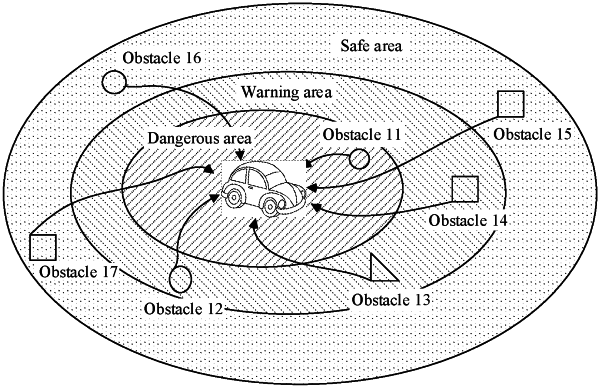| CPC B60W 30/09 (2013.01) [B60W 30/085 (2013.01); B60W 30/18109 (2013.01); B60W 40/105 (2013.01); B60W 60/0015 (2020.02); B60W 2554/4049 (2020.02)] | 13 Claims |

|
1. A vehicle control method comprising:
obtaining a first velocity planned for an intelligent vehicle to travel in a first area, wherein the first area is an area in a process in which the intelligent vehicle travels to a destination;
obtaining, according to a collision potential energy, a second velocity planned for the intelligent vehicle to travel in the first area, wherein the collision potential energy is used to identify a trend of a collision between a surrounding obstacle and the intelligent vehicle;
obtaining, according to the first velocity, the second velocity and a collision risk, an optimal velocity of the intelligent vehicle, wherein the collision risk indicates a risk of a collision between the intelligent vehicle and the surrounding obstacle; and
controlling the intelligent vehicle to travel at the optimal velocity in the first area,
wherein the first velocity, the second velocity and the optimal velocity each comprise a direction and a magnitude;
wherein when all the surrounding obstacles with a preset safety risk level are distributed in four quadrants, the method further comprises:
identifying a maximum safe angle in an obstacle-free area;
using a direction of an angular bisector of the maximum safe angle as a direction of the second velocity; and
using a magnitude greater than or equal to a magnitude of a maximum velocity of the surrounding obstacles as a magnitude of the second velocity;
wherein when all the surrounding obstacles with the preset safety risk level are distributed in three quadrants, the method further comprises:
calculating a collision potential energy combination or an orthogonal direction of a collision potential energy combination in an obstacle-free quadrant;
using a combination of all directions in the collision potential energy combination or the orthogonal direction of the collision potential energy combination in the obstacle-free quadrant as a direction of the second velocity; and
using a magnitude greater than or equal to a magnitude of a maximum velocity of the surrounding obstacles as a magnitude of the second velocity;
wherein when all the surrounding obstacles with the preset safety risk level are distributed in two adjacent quadrants, the method further comprises:
calculating a combination of orthogonal directions of collision potential energy combinations in an obstacle-free quadrant as a direction of the second velocity; and using a magnitude greater than or equal to a magnitude of a maximum velocity of all the surrounding obstacles with the preset collision risk level as a magnitude of the second velocity; or
calculating a collision potential energy combination of all surrounding obstacles with the preset collision risk level in a same quadrant; determining an orthogonal direction of each collision potential energy combination; comparing collision potential energy combinations in the two quadrants in an obstacle-free quadrant; and performing one of:
when the collision potential energy combinations in the two quadrants are equal, calculating a combination of the collision potential energy combinations in the two quadrants, and using the combination of the collision potential energy combinations in the two quadrants as the second velocity, wherein a direction of the combination of the collision potential energy combinations in the two quadrants is a direction of the second velocity, and a magnitude of the combination of the collision potential energy combinations in the two quadrants is a magnitude of the second velocity; or
when the collision potential energy combinations in the two quadrants are not equal, calculating a combination of orthogonal directions of the collision potential energy combinations in the two quadrants, and using the combination of the orthogonal directions of the collision potential energy combinations in the two quadrants as the second velocity, wherein a magnitude of the orthogonal direction of the collision potential energy combination is a magnitude of the collision potential energy combination, and a direction of the orthogonal direction of the collision potential energy combination is a direction perpendicular to the collision potential energy combination;
wherein when all the surrounding obstacles with the preset safety risk level are distributed in two non-adjacent quadrants, the method further comprises: separately calculating a collision potential energy combination of all surrounding obstacles with the preset collision risk level in a same quadrant;
obtaining an orthogonal direction of each collision potential energy combination;
calculating a combination of orthogonal directions that are of collision potential energy combinations and that belong to a same quadrant, using any direction of the combination of the orthogonal directions that are of the collision potential energy combinations and that belong to the same quadrant as a direction of the second velocity; and
using a magnitude greater than or equal to a magnitude of a maximum velocity of the surrounding obstacles as a magnitude of the second velocity; and
wherein when all the surrounding obstacles with the preset collision risk level are distributed in only one quadrant, the method further comprises:
calculating a collision potential energy combination of all the surrounding obstacles with the preset collision risk level;
using an orthogonal direction of the collision potential energy combination as a direction of the second velocity; and
using a magnitude greater than or equal to a magnitude of a maximum velocity of the surrounding obstacles as a magnitude of the second velocity.
|